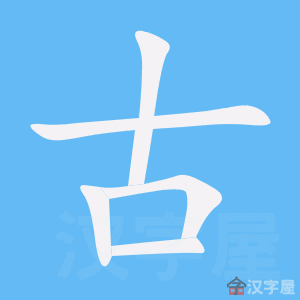|
古琴
gǔ qín
|
guqin or qin, a long zither with seven strings, plucked with the fingers
|
|
古生代
gǔ shēng dài
|
Paleozoic, geological era 545-250m years ago, covering Cambrian 寒武紀|寒武纪, Ordovician 奧陶紀|奥陶纪, Silurian 志留紀|志留纪, Devonian 泥盆紀|泥盆纪, Carboniferous 石炭紀|石炭纪, Permian 二疊紀|二叠纪
|
|
古生物學
gǔ shēng wù xué
|
palaeontology
|
|
古生物學家
gǔ shēng wù xué jiā
|
palaeontologist;
paleobiologist
|
|
古田县
gǔ tián xiàn
|
Gutian county in Ningde 寧德|宁德[Ning2 de2], Fujian
|
|
古田縣
gǔ tián xiàn
|
Gutian county in Ningde 寧德|宁德[Ning2 de2], Fujian
|
|
古登堡
gǔ dēng bǎo
|
Gutenberg (name);
Johannes Gutenberg (c. 1400-1468), inventor in Europe of the printing press;
Beno Gutenberg (1889-1960), German-born US seismologist, coinventor of the Richter magnitude scale
|
|
古盗鸟
gǔ dào niǎo
|
Archaeoraptor (bird-like dinosaur)
|
|
古盜鳥
gǔ dào niǎo
|
Archaeoraptor (bird-like dinosaur)
|
|
古砚
gǔ yàn
|
antique ink slab;
CL:台[tai2]
|
|
古硯
gǔ yàn
|
antique ink slab;
CL:台[tai2]
|
|
古稀
gǔ xī
|
seventy years old
|
|
古筝
gǔ zhēng
|
zither or guzheng;
large zither with 13 to 25 strings, developed from guqin 古琴[gu3 qin2] during Tang and Song times
|
|
古箏
gǔ zhēng
|
zither or guzheng;
large zither with 13 to 25 strings, developed from guqin 古琴[gu3 qin2] during Tang and Song times
|
|
古县
gǔ xiàn
|
Gu county in Linfen 臨汾|临汾[Lin2 fen2], Shanxi
|
|
古縣
gǔ xiàn
|
Gu county in Linfen 臨汾|临汾[Lin2 fen2], Shanxi
|
|
古纤道
gǔ qiàn dào
|
Old Towpath along the Grand Canal in Zhejiang Province
|
|
古縴道
gǔ qiàn dào
|
Old Towpath along the Grand Canal in Zhejiang Province
|
|
古羅馬
gǔ luó mǎ
|
ancient Rome
|
|
古义
gǔ yì
|
ancient meaning;
original or etymological meaning of a word
|
|
古義
gǔ yì
|
ancient meaning;
original or etymological meaning of a word
|
|
古老肉
gǔ lǎo ròu
|
sweet and sour pork;
also written 咕嚕肉|咕噜肉[gu1 lu1 rou4]
|
|
古脊椎动物学
gǔ jǐ zhuī dòng wù xué
|
vertebrate paleontology
|
|
古脊椎動物學
gǔ jǐ zhuī dòng wù xué
|
vertebrate paleontology
|
|
古舊
gǔ jiù
|
archaic
|

